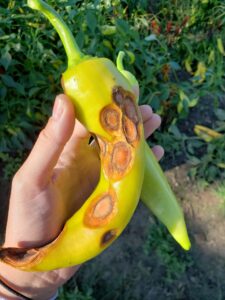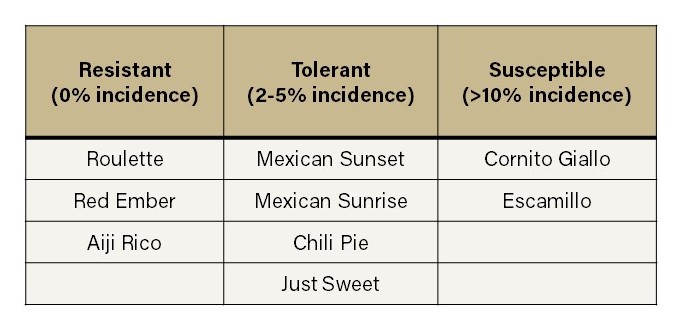A new strain of the disease anthracnose of pepper has been detected in South Carolina and Ontario, Canada. Although this disease has not been found in Indiana, the article reprinted below will help growers to be aware of this potential problem. Pay close attention to the description of the disease and the photo. Don’t hesitate to contact me with questions or comments. Thanks to Katie Goldenhar and Amanda Tracey of the Ontario Ministry of Agriculture, Food and Rural Affairs for letting us adapt this article for the Vegetable Crops Hotline. The original article can be found here. I have modified the fungicide information from the original article to fit fungicide labeling in the U.S.
Anthracnose in Ontario field peppers has been historically caused by the fungal pathogens Colletotrichum coccodes and C. dematium. These are endemic to Ontario and mainly infect ripe fruit. The disease has typically been controllable through fungicides applied on a 14-day interval starting after fruit set. In 2020, a severe anthracnose outbreak occurred in one processing pepper field. Samples were taken from the field, sent for diagnosis, and subsequently identified as Colletotrichum scovillei, a new species to Ontario. In 2021, anthracnose in peppers was seen in late July in multiple pepper fields. The disease spread quickly and was extremely aggressive, with more than 80% of fruit (immature and mature) infected with at least one lesion by late August.
Colletotrichum scovillei has been reported in South Carolina, Brazil, China, Indonesia, Japan, Malaysia, South Korea, Taiwan, and Thailand. Colletotrichum scovillei is part of the C. acutatum species complex, which can cause symptoms on immature fruit. Colletotrichum scovillei hosts are primarily within the Capsicum (pepper) family.
Biology and Spread
Colletotrichum species may overwinter on infected pepper fruit left in the field or on infected plant material at the end of the production season. Additionally, if crop debris remains on equipment, this may serve as an overwintering source for the disease. Pepper anthracnose usually starts out as a ‘hot spot’ in the field and then fans out directionally with the prevailing wind and driving rain. The spores of Colletotrichum species are spread through splashing water, rain or irrigation, driving winds, and equipment/people. Hot weather, along with afternoon and evening showers, are ideal conditions for anthracnose development.

Figure 1. Anthracnose of a banana pepper caused by a new strain of the anthracnose fungus. This disease has not been found in Indiana, but growers should be vigilant. Photo by K. Goldenhar.
Symptoms
Colletotrichum species are known to have latent infection periods, where they infect flowers or developing fruit and do not show symptoms until weeks after. Colletotrichum scovillei can cause lesions on small, immature fruit as well as mature fruit. Samples of asymptomatic fruit were collected and fruit without any visible lesions (between 1-5 cm) was found to be already infected. Infected fruit can have one or more soft, sunken lesions covered with salmon-colored spore masses (Figure 1).
Management
Cultural controls for anthracnose should include starting with clean transplants. Scout regularly and remove infected plants, including plants surrounding the diseased one, as soon as symptoms are seen. Rotating away from peppers, ideally a 3-year rotation or more, can help reduce inoculum pressure. Avoiding the use of overhead irrigation can help reduce the leaf wetness period needed for infection. The remaining plant debris should be mulched/mowed and then incorporated into the soil as soon as harvest is finished to allow for the soil microorganisms to break down the residue. Clean and disinfect equipment, including irrigation hoses, baskets, tractors, trucks, wagons, etc., before storage.
Fungicide applications targeting anthracnose should start at flowering and continue on a 7-to-10-day interval until harvest. Make sure the sprayer is well calibrated and the fruit is receiving adequate coverage. Fungicides that should be effective include products with FRAC group 11 active ingredients such as Quadris® and Quadris Top®; Aprovia Top®; contact fungicides with the active ingredient chlorothalonil (e.g., Bravo®, Echo® , Equus®, Initiate®) and mancozeb (e.g., Dithane®, Manzate®, Penncozeb®). See the Midwest Vegetable Guide for 2023 and the fungicide label.
Other management strategies could include host resistance. Based on a report from South Carolina, Table 1 outlines some cultivars that showed reduced disease development. None of these cultivars are suitable for Ontario production. However, it does demonstrate that there may be some genetic resistance in commercial cultivars that could be incorporated into northern cultivars.
Table 1. Cultivars tested in South Carolina against Colletotrichum scovillei
Pepper growers should keep anthracnose at the top of their minds as planning continues for the 2023 field season. Contact me if you think you may have this disease in your fields or have questions.
References
A.P. Keinath, S.H. Zardus, and V.B. Dubose, and G. Rennberger. (2021) Evaluation of All-America Selections peppers, 2020. Plant Disease Management Reports 15: V040.
Farr, D.F., & Rossman, A.Y. Fungal Databases, U.S. National Fungus Collections, ARS, USDA. Retrieved March 2, 2022, from https://nt.ars-grin.gov/fungaldatabases/
Toporek, S. M., & Keinath, A. P. (2021). First Report of Colletotrichum scovillei Causing Anthracnose Fruit Rot on Pepper in South Carolina, United States. Plant Disease, 105(4), 1222-1222. https://apsjournals.apsnet.org/doi/full/10.1094/PDIS-08-20-1656-PDN